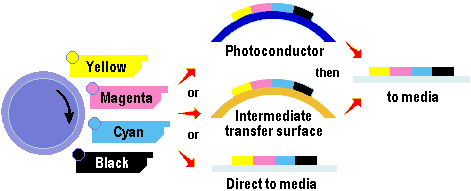Laser printers are usually monochrome devices, but as with most mono technologies, laser printing can be adapted to colour. It does this by using cyan, magenta and yellow in combination to produce the different printable colours. Four passes through the electro-photographic process are performed, generally placing toners on the page one at a time or building up the four-colour image on an intermediate transfer surface.

Most modern laser printers have a native resolution of 600 or 1200dpi. Lower resolution models can often vary the intensity of their laser/LED spots, but deliver coarser multi-level toner dots resulting in mixed contone and halftone printing, rather than continuous tone output. Rated print speeds vary between 3 and 5ppm in colour and 12 to 14ppm in monochrome. A key area of development, pioneered by Lexmark’s 12ppm LED printer launched in the autumn of 1998, is to boost colour print speed up to the same level as mono with simultaneous processing of the four toners and one-pass printing.
The Lexmark Optra Colour 1200N achieves this by having completely separate processes for each colour. The compactness which results from use of LED arrays instead of the bulky focusing paraphernalia associated with a laser imaging unit allows the colour engine to be built with four complete printheads arranged. The CMY and K toner cartridges are laid out in-line down the paper path and each unit has its own photo-conductive drum. Above each unit in the printer’s lid are four LED arrays – again, one for each colour. Data can be sent to all four heads simultaneously. The process starts with magenta and passes through cyan and yellow, with black laid down last.
Apart from their speed, one of the main advantages of colour lasers is the durability of their output – a function of the chemically inert toners that are fused onto the paper’s surface rather than absorbed into it, as with most inkjets. This allows colour lasers to print well on a variety of media, without the problems of smudging and fading that beset many inkjets. Furthermore, by controlling the amount of heat and pressure in the fusing process, output can be given a user-controllable finish, from matte through to gloss.
If history is anything to go by, the future for laser and LED colour printing looks bright. Within four years of the first appearance of colour lasers in 1994 prices approximately halved. With the market continuing to be stimulated, both by falling prices and improved technology, it looks inevitable that the laser or LED colour laser will become as commonplace and as indispensable as the photocopier.